Strategic Leadership and Change Management: Strategies and Analysis
VerifiedAdded on 2023/04/05
|25
|5444
|121
Report
AI Summary
This report provides an in-depth analysis of strategic leadership and change management concepts, focusing on strategies for organizational success. It examines McDonald's "Plan to Win" strategy, highlighting key initiatives related to people, product, place, price, and promotion. The report evaluates the characteristics of winning strategies and explores the phases of strategy-making and execution, emphasizing the importance of vision, mission, and values. It differentiates between mission and vision statements and discusses the obligations of a Board of Directors, contrasting financial and strategic objectives. Furthermore, the application of competitive strategies and the role of strategic alliances are examined to enhance overall management effectiveness. The report concludes with recommendations for improving strategic leadership and change management practices.
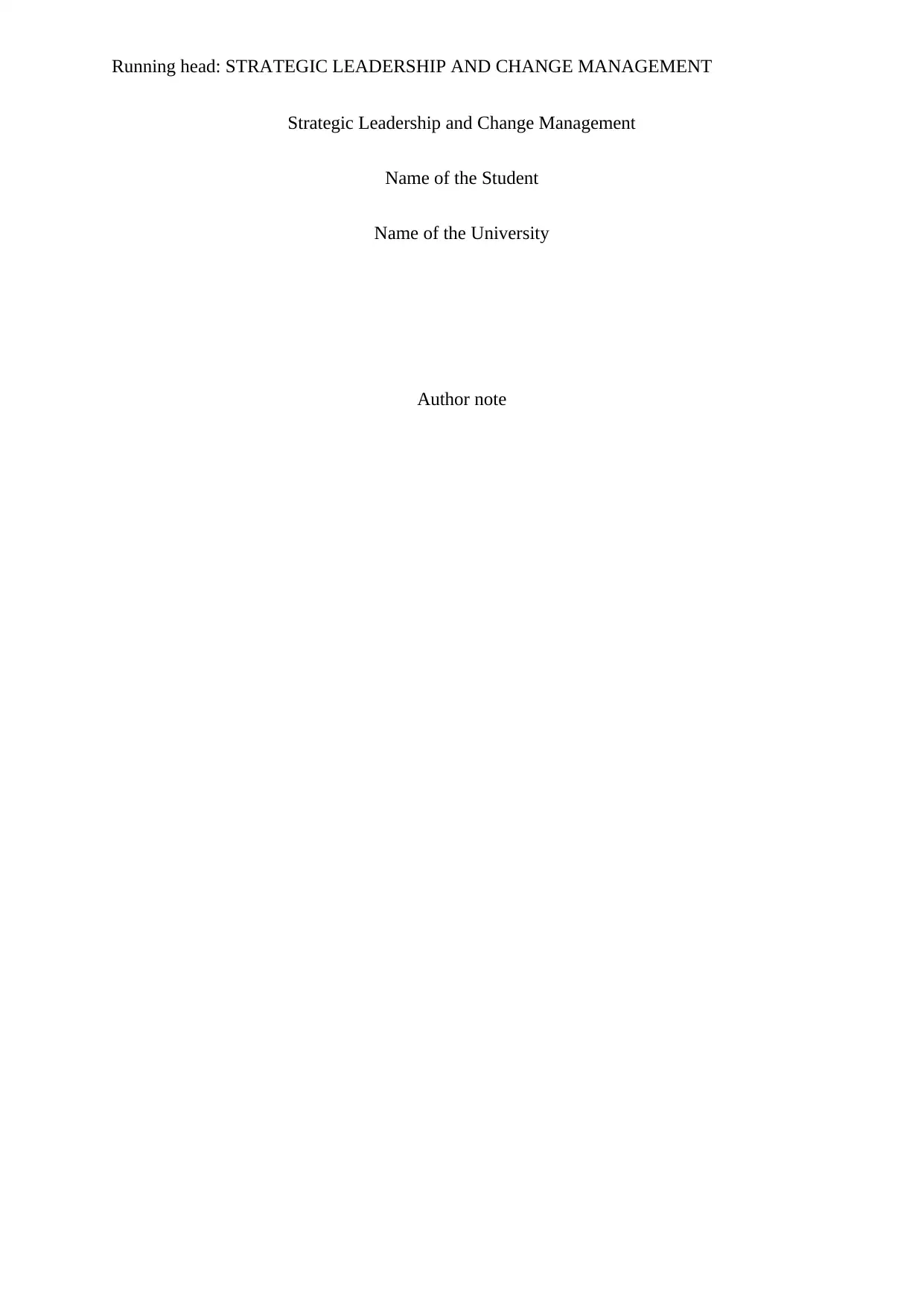
Running head: STRATEGIC LEADERSHIP AND CHANGE MANAGEMENT
Strategic Leadership and Change Management
Name of the Student
Name of the University
Author note
Strategic Leadership and Change Management
Name of the Student
Name of the University
Author note
Paraphrase This Document
Need a fresh take? Get an instant paraphrase of this document with our AI Paraphraser
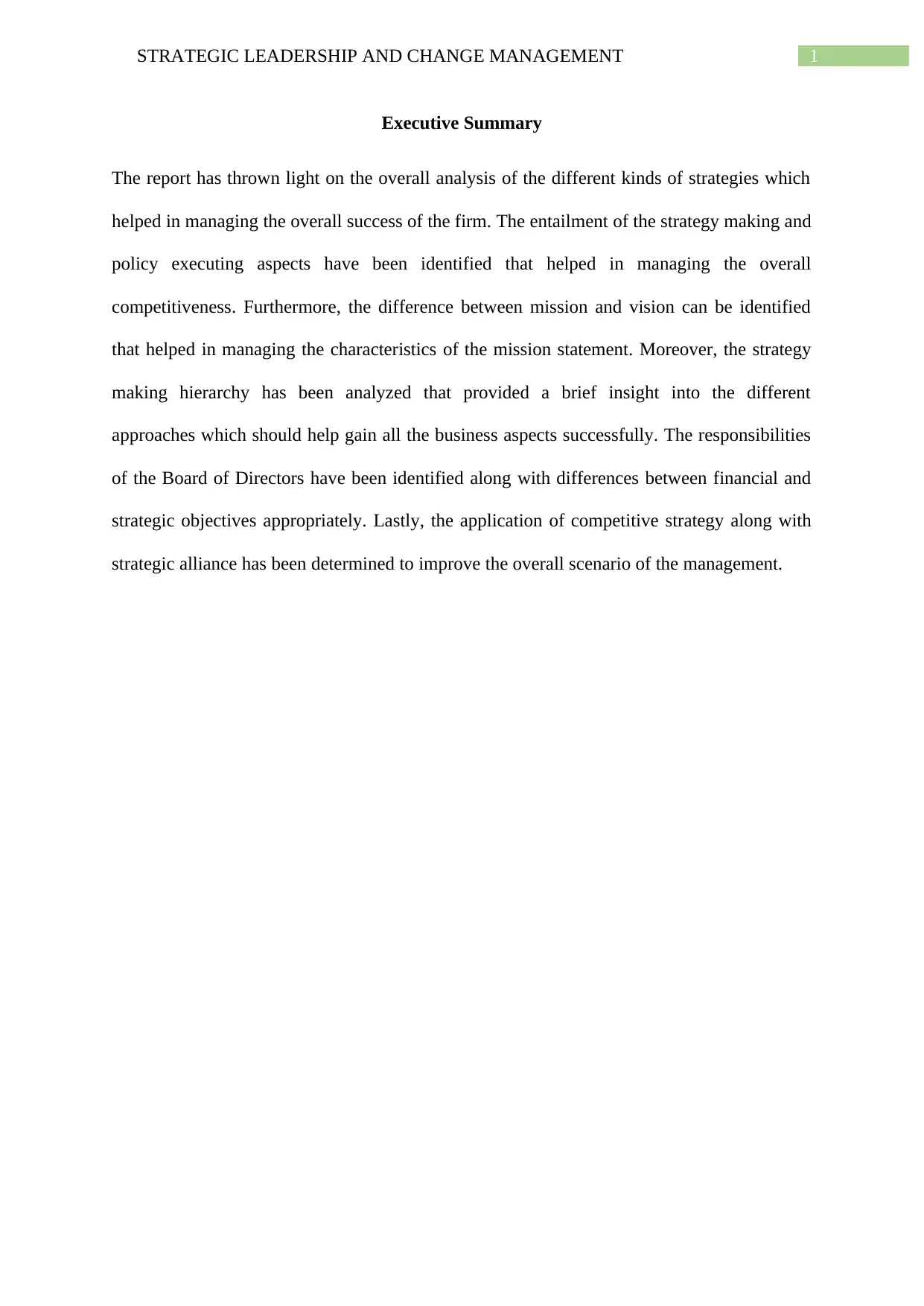
1STRATEGIC LEADERSHIP AND CHANGE MANAGEMENT
Executive Summary
The report has thrown light on the overall analysis of the different kinds of strategies which
helped in managing the overall success of the firm. The entailment of the strategy making and
policy executing aspects have been identified that helped in managing the overall
competitiveness. Furthermore, the difference between mission and vision can be identified
that helped in managing the characteristics of the mission statement. Moreover, the strategy
making hierarchy has been analyzed that provided a brief insight into the different
approaches which should help gain all the business aspects successfully. The responsibilities
of the Board of Directors have been identified along with differences between financial and
strategic objectives appropriately. Lastly, the application of competitive strategy along with
strategic alliance has been determined to improve the overall scenario of the management.
Executive Summary
The report has thrown light on the overall analysis of the different kinds of strategies which
helped in managing the overall success of the firm. The entailment of the strategy making and
policy executing aspects have been identified that helped in managing the overall
competitiveness. Furthermore, the difference between mission and vision can be identified
that helped in managing the characteristics of the mission statement. Moreover, the strategy
making hierarchy has been analyzed that provided a brief insight into the different
approaches which should help gain all the business aspects successfully. The responsibilities
of the Board of Directors have been identified along with differences between financial and
strategic objectives appropriately. Lastly, the application of competitive strategy along with
strategic alliance has been determined to improve the overall scenario of the management.
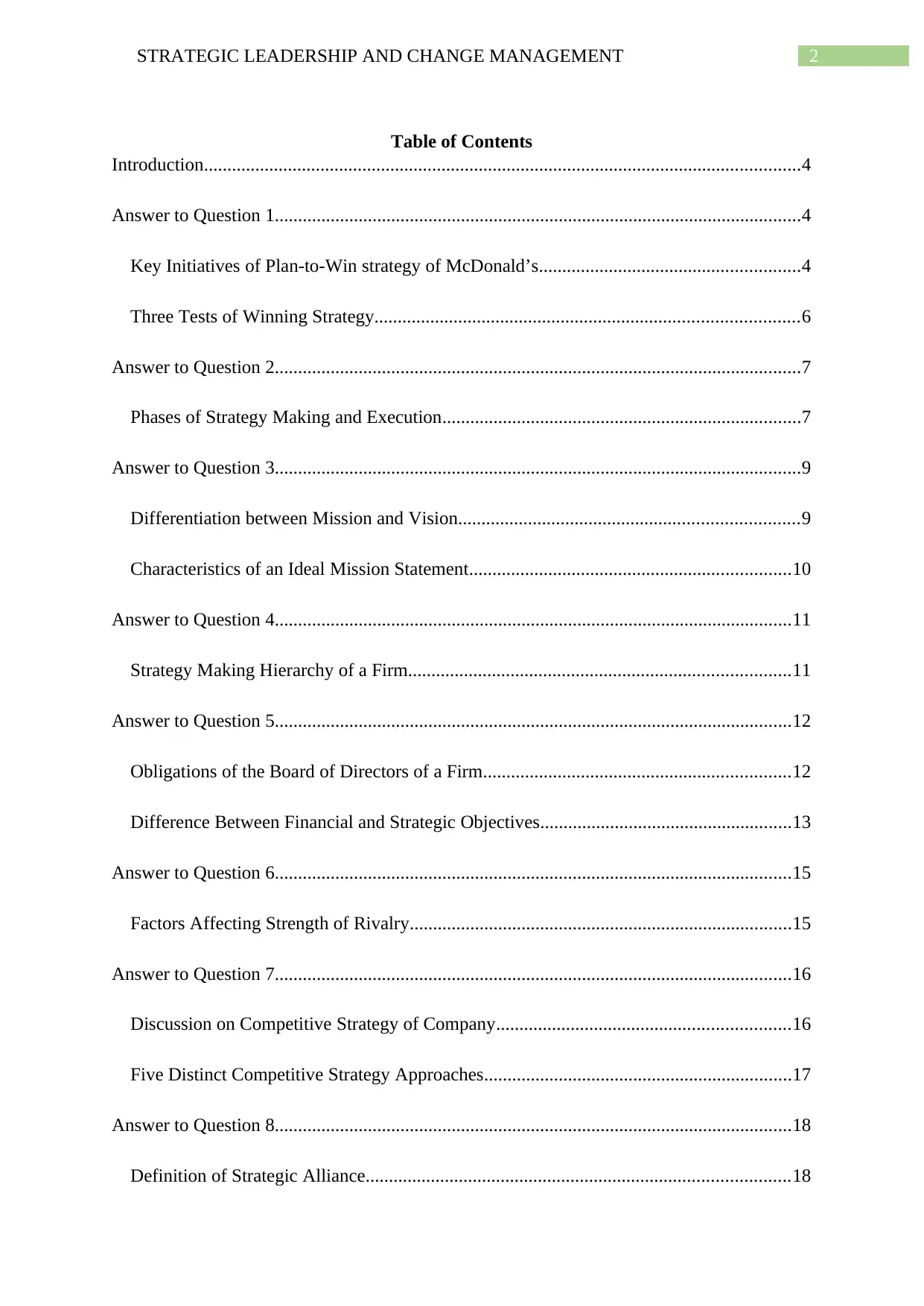
2STRATEGIC LEADERSHIP AND CHANGE MANAGEMENT
Table of Contents
Introduction................................................................................................................................4
Answer to Question 1.................................................................................................................4
Key Initiatives of Plan-to-Win strategy of McDonald’s........................................................4
Three Tests of Winning Strategy...........................................................................................6
Answer to Question 2.................................................................................................................7
Phases of Strategy Making and Execution.............................................................................7
Answer to Question 3.................................................................................................................9
Differentiation between Mission and Vision.........................................................................9
Characteristics of an Ideal Mission Statement.....................................................................10
Answer to Question 4...............................................................................................................11
Strategy Making Hierarchy of a Firm..................................................................................11
Answer to Question 5...............................................................................................................12
Obligations of the Board of Directors of a Firm..................................................................12
Difference Between Financial and Strategic Objectives......................................................13
Answer to Question 6...............................................................................................................15
Factors Affecting Strength of Rivalry..................................................................................15
Answer to Question 7...............................................................................................................16
Discussion on Competitive Strategy of Company...............................................................16
Five Distinct Competitive Strategy Approaches..................................................................17
Answer to Question 8...............................................................................................................18
Definition of Strategic Alliance...........................................................................................18
Table of Contents
Introduction................................................................................................................................4
Answer to Question 1.................................................................................................................4
Key Initiatives of Plan-to-Win strategy of McDonald’s........................................................4
Three Tests of Winning Strategy...........................................................................................6
Answer to Question 2.................................................................................................................7
Phases of Strategy Making and Execution.............................................................................7
Answer to Question 3.................................................................................................................9
Differentiation between Mission and Vision.........................................................................9
Characteristics of an Ideal Mission Statement.....................................................................10
Answer to Question 4...............................................................................................................11
Strategy Making Hierarchy of a Firm..................................................................................11
Answer to Question 5...............................................................................................................12
Obligations of the Board of Directors of a Firm..................................................................12
Difference Between Financial and Strategic Objectives......................................................13
Answer to Question 6...............................................................................................................15
Factors Affecting Strength of Rivalry..................................................................................15
Answer to Question 7...............................................................................................................16
Discussion on Competitive Strategy of Company...............................................................16
Five Distinct Competitive Strategy Approaches..................................................................17
Answer to Question 8...............................................................................................................18
Definition of Strategic Alliance...........................................................................................18
⊘ This is a preview!⊘
Do you want full access?
Subscribe today to unlock all pages.

Trusted by 1+ million students worldwide
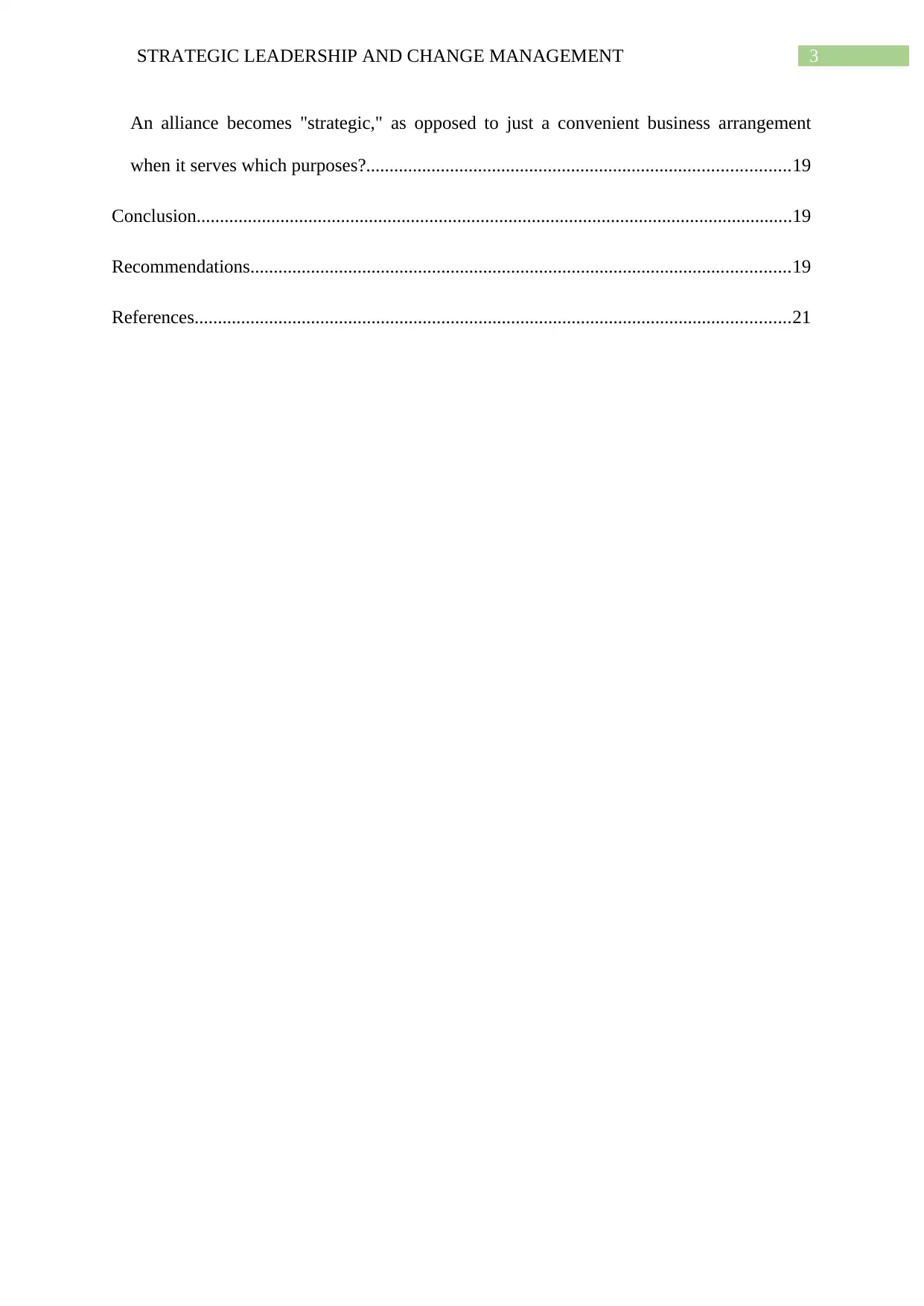
3STRATEGIC LEADERSHIP AND CHANGE MANAGEMENT
An alliance becomes "strategic," as opposed to just a convenient business arrangement
when it serves which purposes?...........................................................................................19
Conclusion................................................................................................................................19
Recommendations....................................................................................................................19
References................................................................................................................................21
An alliance becomes "strategic," as opposed to just a convenient business arrangement
when it serves which purposes?...........................................................................................19
Conclusion................................................................................................................................19
Recommendations....................................................................................................................19
References................................................................................................................................21
Paraphrase This Document
Need a fresh take? Get an instant paraphrase of this document with our AI Paraphraser
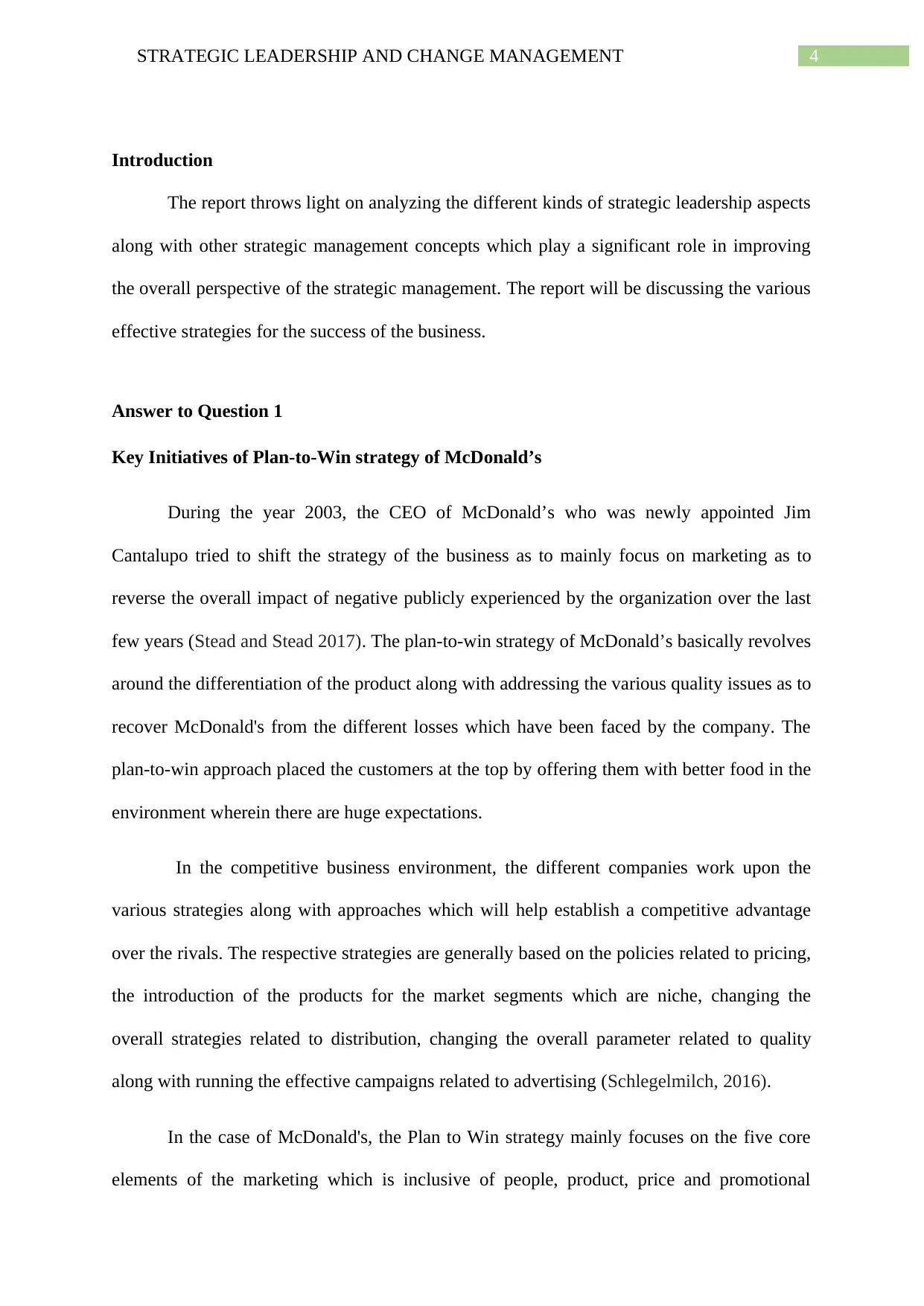
4STRATEGIC LEADERSHIP AND CHANGE MANAGEMENT
Introduction
The report throws light on analyzing the different kinds of strategic leadership aspects
along with other strategic management concepts which play a significant role in improving
the overall perspective of the strategic management. The report will be discussing the various
effective strategies for the success of the business.
Answer to Question 1
Key Initiatives of Plan-to-Win strategy of McDonald’s
During the year 2003, the CEO of McDonald’s who was newly appointed Jim
Cantalupo tried to shift the strategy of the business as to mainly focus on marketing as to
reverse the overall impact of negative publicly experienced by the organization over the last
few years (Stead and Stead 2017). The plan-to-win strategy of McDonald’s basically revolves
around the differentiation of the product along with addressing the various quality issues as to
recover McDonald's from the different losses which have been faced by the company. The
plan-to-win approach placed the customers at the top by offering them with better food in the
environment wherein there are huge expectations.
In the competitive business environment, the different companies work upon the
various strategies along with approaches which will help establish a competitive advantage
over the rivals. The respective strategies are generally based on the policies related to pricing,
the introduction of the products for the market segments which are niche, changing the
overall strategies related to distribution, changing the overall parameter related to quality
along with running the effective campaigns related to advertising (Schlegelmilch, 2016).
In the case of McDonald's, the Plan to Win strategy mainly focuses on the five core
elements of the marketing which is inclusive of people, product, price and promotional
Introduction
The report throws light on analyzing the different kinds of strategic leadership aspects
along with other strategic management concepts which play a significant role in improving
the overall perspective of the strategic management. The report will be discussing the various
effective strategies for the success of the business.
Answer to Question 1
Key Initiatives of Plan-to-Win strategy of McDonald’s
During the year 2003, the CEO of McDonald’s who was newly appointed Jim
Cantalupo tried to shift the strategy of the business as to mainly focus on marketing as to
reverse the overall impact of negative publicly experienced by the organization over the last
few years (Stead and Stead 2017). The plan-to-win strategy of McDonald’s basically revolves
around the differentiation of the product along with addressing the various quality issues as to
recover McDonald's from the different losses which have been faced by the company. The
plan-to-win approach placed the customers at the top by offering them with better food in the
environment wherein there are huge expectations.
In the competitive business environment, the different companies work upon the
various strategies along with approaches which will help establish a competitive advantage
over the rivals. The respective strategies are generally based on the policies related to pricing,
the introduction of the products for the market segments which are niche, changing the
overall strategies related to distribution, changing the overall parameter related to quality
along with running the effective campaigns related to advertising (Schlegelmilch, 2016).
In the case of McDonald's, the Plan to Win strategy mainly focuses on the five core
elements of the marketing which is inclusive of people, product, price and promotional
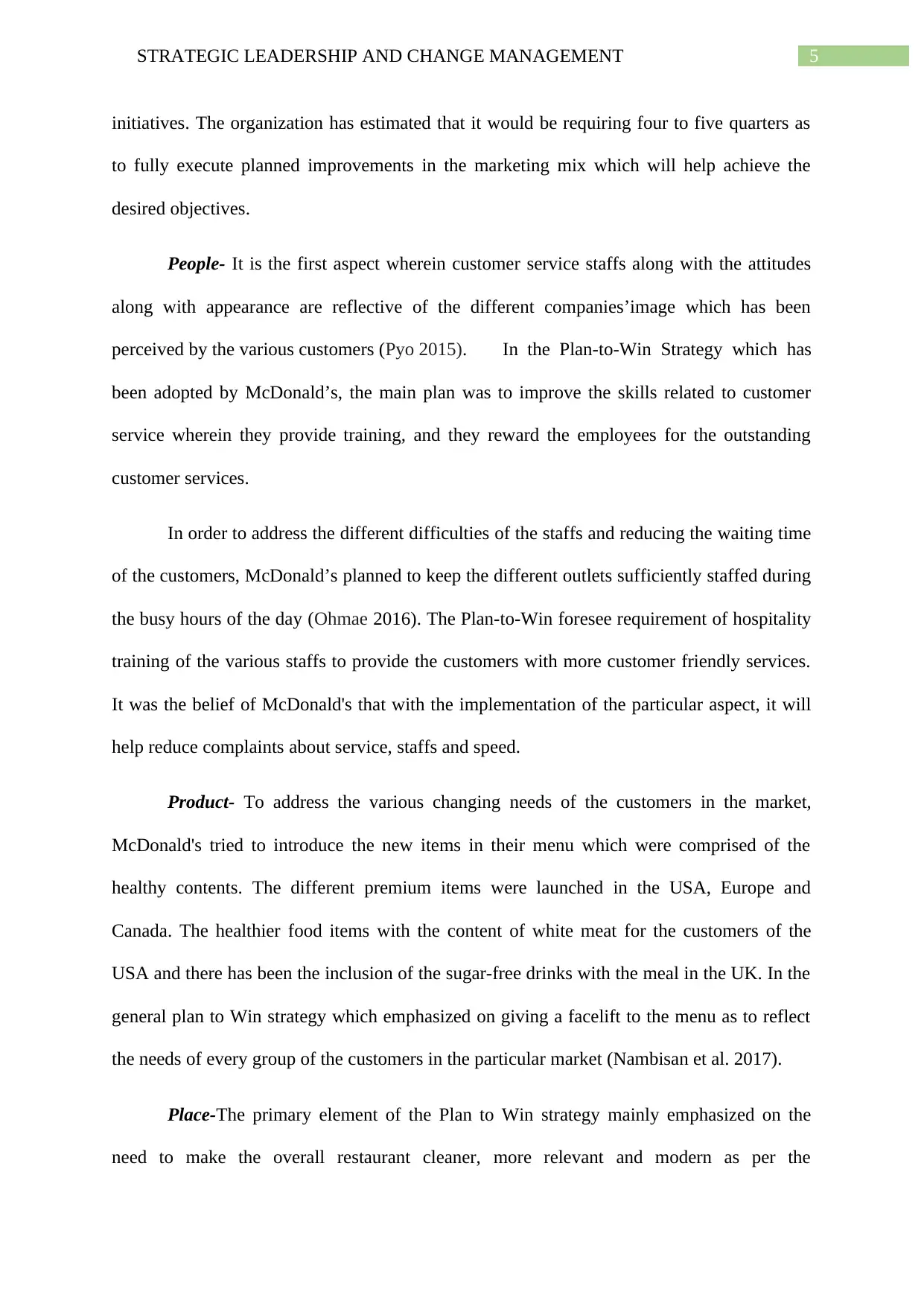
5STRATEGIC LEADERSHIP AND CHANGE MANAGEMENT
initiatives. The organization has estimated that it would be requiring four to five quarters as
to fully execute planned improvements in the marketing mix which will help achieve the
desired objectives.
People- It is the first aspect wherein customer service staffs along with the attitudes
along with appearance are reflective of the different companies’image which has been
perceived by the various customers (Pyo 2015). In the Plan-to-Win Strategy which has
been adopted by McDonald’s, the main plan was to improve the skills related to customer
service wherein they provide training, and they reward the employees for the outstanding
customer services.
In order to address the different difficulties of the staffs and reducing the waiting time
of the customers, McDonald’s planned to keep the different outlets sufficiently staffed during
the busy hours of the day (Ohmae 2016). The Plan-to-Win foresee requirement of hospitality
training of the various staffs to provide the customers with more customer friendly services.
It was the belief of McDonald's that with the implementation of the particular aspect, it will
help reduce complaints about service, staffs and speed.
Product- To address the various changing needs of the customers in the market,
McDonald's tried to introduce the new items in their menu which were comprised of the
healthy contents. The different premium items were launched in the USA, Europe and
Canada. The healthier food items with the content of white meat for the customers of the
USA and there has been the inclusion of the sugar-free drinks with the meal in the UK. In the
general plan to Win strategy which emphasized on giving a facelift to the menu as to reflect
the needs of every group of the customers in the particular market (Nambisan et al. 2017).
Place-The primary element of the Plan to Win strategy mainly emphasized on the
need to make the overall restaurant cleaner, more relevant and modern as per the
initiatives. The organization has estimated that it would be requiring four to five quarters as
to fully execute planned improvements in the marketing mix which will help achieve the
desired objectives.
People- It is the first aspect wherein customer service staffs along with the attitudes
along with appearance are reflective of the different companies’image which has been
perceived by the various customers (Pyo 2015). In the Plan-to-Win Strategy which has
been adopted by McDonald’s, the main plan was to improve the skills related to customer
service wherein they provide training, and they reward the employees for the outstanding
customer services.
In order to address the different difficulties of the staffs and reducing the waiting time
of the customers, McDonald’s planned to keep the different outlets sufficiently staffed during
the busy hours of the day (Ohmae 2016). The Plan-to-Win foresee requirement of hospitality
training of the various staffs to provide the customers with more customer friendly services.
It was the belief of McDonald's that with the implementation of the particular aspect, it will
help reduce complaints about service, staffs and speed.
Product- To address the various changing needs of the customers in the market,
McDonald's tried to introduce the new items in their menu which were comprised of the
healthy contents. The different premium items were launched in the USA, Europe and
Canada. The healthier food items with the content of white meat for the customers of the
USA and there has been the inclusion of the sugar-free drinks with the meal in the UK. In the
general plan to Win strategy which emphasized on giving a facelift to the menu as to reflect
the needs of every group of the customers in the particular market (Nambisan et al. 2017).
Place-The primary element of the Plan to Win strategy mainly emphasized on the
need to make the overall restaurant cleaner, more relevant and modern as per the
⊘ This is a preview!⊘
Do you want full access?
Subscribe today to unlock all pages.

Trusted by 1+ million students worldwide
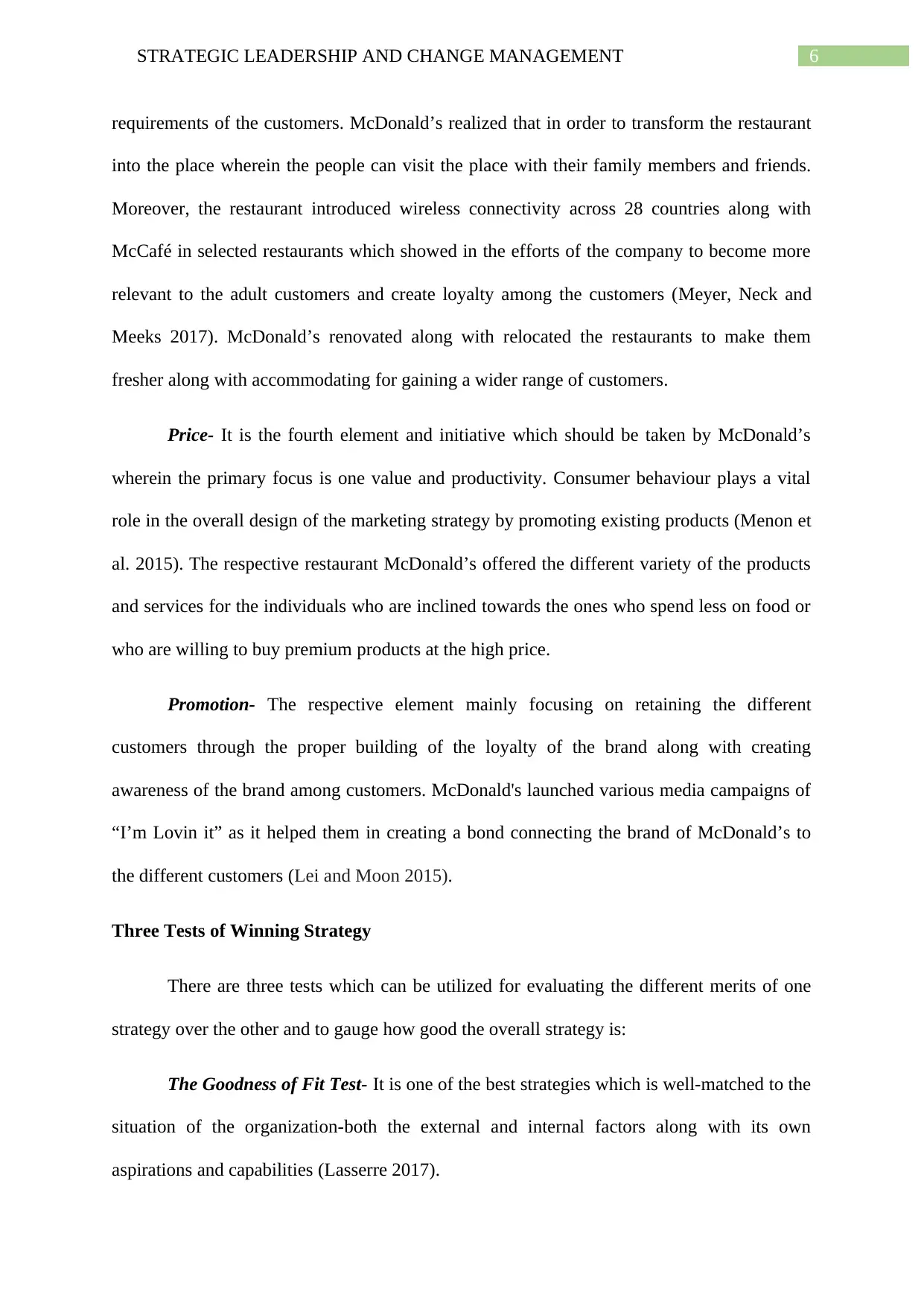
6STRATEGIC LEADERSHIP AND CHANGE MANAGEMENT
requirements of the customers. McDonald’s realized that in order to transform the restaurant
into the place wherein the people can visit the place with their family members and friends.
Moreover, the restaurant introduced wireless connectivity across 28 countries along with
McCafé in selected restaurants which showed in the efforts of the company to become more
relevant to the adult customers and create loyalty among the customers (Meyer, Neck and
Meeks 2017). McDonald’s renovated along with relocated the restaurants to make them
fresher along with accommodating for gaining a wider range of customers.
Price- It is the fourth element and initiative which should be taken by McDonald’s
wherein the primary focus is one value and productivity. Consumer behaviour plays a vital
role in the overall design of the marketing strategy by promoting existing products (Menon et
al. 2015). The respective restaurant McDonald’s offered the different variety of the products
and services for the individuals who are inclined towards the ones who spend less on food or
who are willing to buy premium products at the high price.
Promotion- The respective element mainly focusing on retaining the different
customers through the proper building of the loyalty of the brand along with creating
awareness of the brand among customers. McDonald's launched various media campaigns of
“I’m Lovin it” as it helped them in creating a bond connecting the brand of McDonald’s to
the different customers (Lei and Moon 2015).
Three Tests of Winning Strategy
There are three tests which can be utilized for evaluating the different merits of one
strategy over the other and to gauge how good the overall strategy is:
The Goodness of Fit Test- It is one of the best strategies which is well-matched to the
situation of the organization-both the external and internal factors along with its own
aspirations and capabilities (Lasserre 2017).
requirements of the customers. McDonald’s realized that in order to transform the restaurant
into the place wherein the people can visit the place with their family members and friends.
Moreover, the restaurant introduced wireless connectivity across 28 countries along with
McCafé in selected restaurants which showed in the efforts of the company to become more
relevant to the adult customers and create loyalty among the customers (Meyer, Neck and
Meeks 2017). McDonald’s renovated along with relocated the restaurants to make them
fresher along with accommodating for gaining a wider range of customers.
Price- It is the fourth element and initiative which should be taken by McDonald’s
wherein the primary focus is one value and productivity. Consumer behaviour plays a vital
role in the overall design of the marketing strategy by promoting existing products (Menon et
al. 2015). The respective restaurant McDonald’s offered the different variety of the products
and services for the individuals who are inclined towards the ones who spend less on food or
who are willing to buy premium products at the high price.
Promotion- The respective element mainly focusing on retaining the different
customers through the proper building of the loyalty of the brand along with creating
awareness of the brand among customers. McDonald's launched various media campaigns of
“I’m Lovin it” as it helped them in creating a bond connecting the brand of McDonald’s to
the different customers (Lei and Moon 2015).
Three Tests of Winning Strategy
There are three tests which can be utilized for evaluating the different merits of one
strategy over the other and to gauge how good the overall strategy is:
The Goodness of Fit Test- It is one of the best strategies which is well-matched to the
situation of the organization-both the external and internal factors along with its own
aspirations and capabilities (Lasserre 2017).
Paraphrase This Document
Need a fresh take? Get an instant paraphrase of this document with our AI Paraphraser
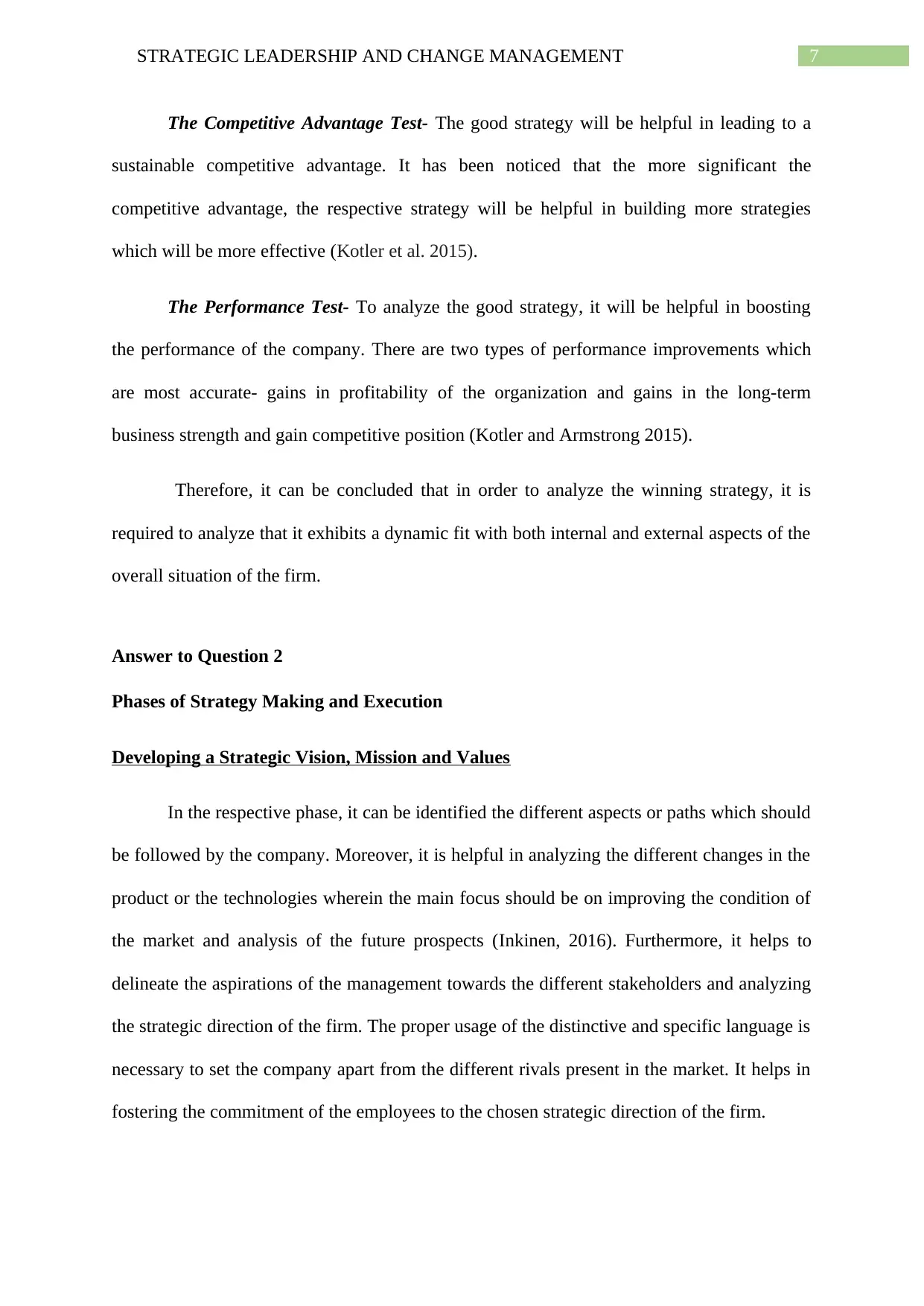
7STRATEGIC LEADERSHIP AND CHANGE MANAGEMENT
The Competitive Advantage Test- The good strategy will be helpful in leading to a
sustainable competitive advantage. It has been noticed that the more significant the
competitive advantage, the respective strategy will be helpful in building more strategies
which will be more effective (Kotler et al. 2015).
The Performance Test- To analyze the good strategy, it will be helpful in boosting
the performance of the company. There are two types of performance improvements which
are most accurate- gains in profitability of the organization and gains in the long-term
business strength and gain competitive position (Kotler and Armstrong 2015).
Therefore, it can be concluded that in order to analyze the winning strategy, it is
required to analyze that it exhibits a dynamic fit with both internal and external aspects of the
overall situation of the firm.
Answer to Question 2
Phases of Strategy Making and Execution
Developing a Strategic Vision, Mission and Values
In the respective phase, it can be identified the different aspects or paths which should
be followed by the company. Moreover, it is helpful in analyzing the different changes in the
product or the technologies wherein the main focus should be on improving the condition of
the market and analysis of the future prospects (Inkinen, 2016). Furthermore, it helps to
delineate the aspirations of the management towards the different stakeholders and analyzing
the strategic direction of the firm. The proper usage of the distinctive and specific language is
necessary to set the company apart from the different rivals present in the market. It helps in
fostering the commitment of the employees to the chosen strategic direction of the firm.
The Competitive Advantage Test- The good strategy will be helpful in leading to a
sustainable competitive advantage. It has been noticed that the more significant the
competitive advantage, the respective strategy will be helpful in building more strategies
which will be more effective (Kotler et al. 2015).
The Performance Test- To analyze the good strategy, it will be helpful in boosting
the performance of the company. There are two types of performance improvements which
are most accurate- gains in profitability of the organization and gains in the long-term
business strength and gain competitive position (Kotler and Armstrong 2015).
Therefore, it can be concluded that in order to analyze the winning strategy, it is
required to analyze that it exhibits a dynamic fit with both internal and external aspects of the
overall situation of the firm.
Answer to Question 2
Phases of Strategy Making and Execution
Developing a Strategic Vision, Mission and Values
In the respective phase, it can be identified the different aspects or paths which should
be followed by the company. Moreover, it is helpful in analyzing the different changes in the
product or the technologies wherein the main focus should be on improving the condition of
the market and analysis of the future prospects (Inkinen, 2016). Furthermore, it helps to
delineate the aspirations of the management towards the different stakeholders and analyzing
the strategic direction of the firm. The proper usage of the distinctive and specific language is
necessary to set the company apart from the different rivals present in the market. It helps in
fostering the commitment of the employees to the chosen strategic direction of the firm.
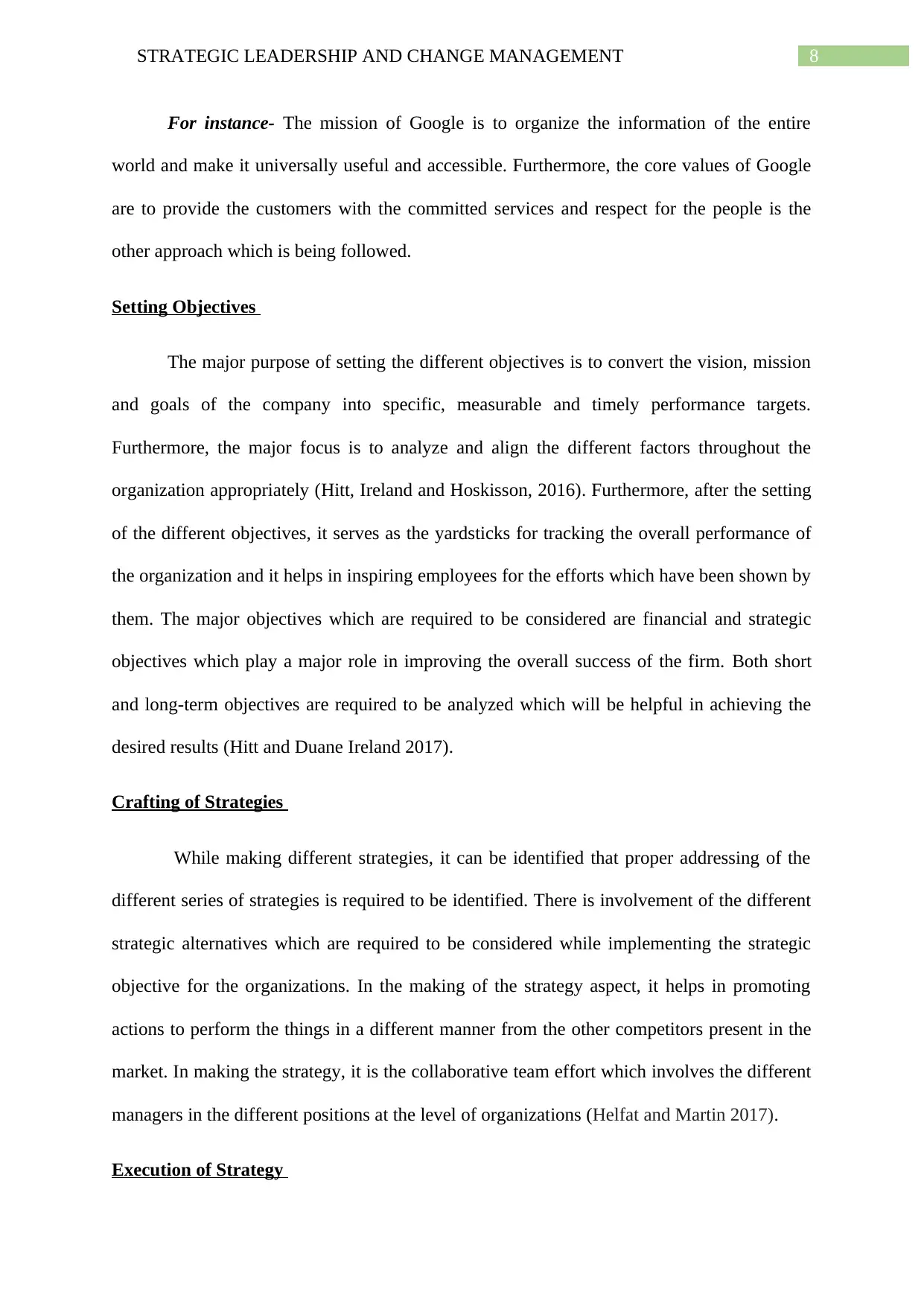
8STRATEGIC LEADERSHIP AND CHANGE MANAGEMENT
For instance- The mission of Google is to organize the information of the entire
world and make it universally useful and accessible. Furthermore, the core values of Google
are to provide the customers with the committed services and respect for the people is the
other approach which is being followed.
Setting Objectives
The major purpose of setting the different objectives is to convert the vision, mission
and goals of the company into specific, measurable and timely performance targets.
Furthermore, the major focus is to analyze and align the different factors throughout the
organization appropriately (Hitt, Ireland and Hoskisson, 2016). Furthermore, after the setting
of the different objectives, it serves as the yardsticks for tracking the overall performance of
the organization and it helps in inspiring employees for the efforts which have been shown by
them. The major objectives which are required to be considered are financial and strategic
objectives which play a major role in improving the overall success of the firm. Both short
and long-term objectives are required to be analyzed which will be helpful in achieving the
desired results (Hitt and Duane Ireland 2017).
Crafting of Strategies
While making different strategies, it can be identified that proper addressing of the
different series of strategies is required to be identified. There is involvement of the different
strategic alternatives which are required to be considered while implementing the strategic
objective for the organizations. In the making of the strategy aspect, it helps in promoting
actions to perform the things in a different manner from the other competitors present in the
market. In making the strategy, it is the collaborative team effort which involves the different
managers in the different positions at the level of organizations (Helfat and Martin 2017).
Execution of Strategy
For instance- The mission of Google is to organize the information of the entire
world and make it universally useful and accessible. Furthermore, the core values of Google
are to provide the customers with the committed services and respect for the people is the
other approach which is being followed.
Setting Objectives
The major purpose of setting the different objectives is to convert the vision, mission
and goals of the company into specific, measurable and timely performance targets.
Furthermore, the major focus is to analyze and align the different factors throughout the
organization appropriately (Hitt, Ireland and Hoskisson, 2016). Furthermore, after the setting
of the different objectives, it serves as the yardsticks for tracking the overall performance of
the organization and it helps in inspiring employees for the efforts which have been shown by
them. The major objectives which are required to be considered are financial and strategic
objectives which play a major role in improving the overall success of the firm. Both short
and long-term objectives are required to be analyzed which will be helpful in achieving the
desired results (Hitt and Duane Ireland 2017).
Crafting of Strategies
While making different strategies, it can be identified that proper addressing of the
different series of strategies is required to be identified. There is involvement of the different
strategic alternatives which are required to be considered while implementing the strategic
objective for the organizations. In the making of the strategy aspect, it helps in promoting
actions to perform the things in a different manner from the other competitors present in the
market. In making the strategy, it is the collaborative team effort which involves the different
managers in the different positions at the level of organizations (Helfat and Martin 2017).
Execution of Strategy
⊘ This is a preview!⊘
Do you want full access?
Subscribe today to unlock all pages.

Trusted by 1+ million students worldwide
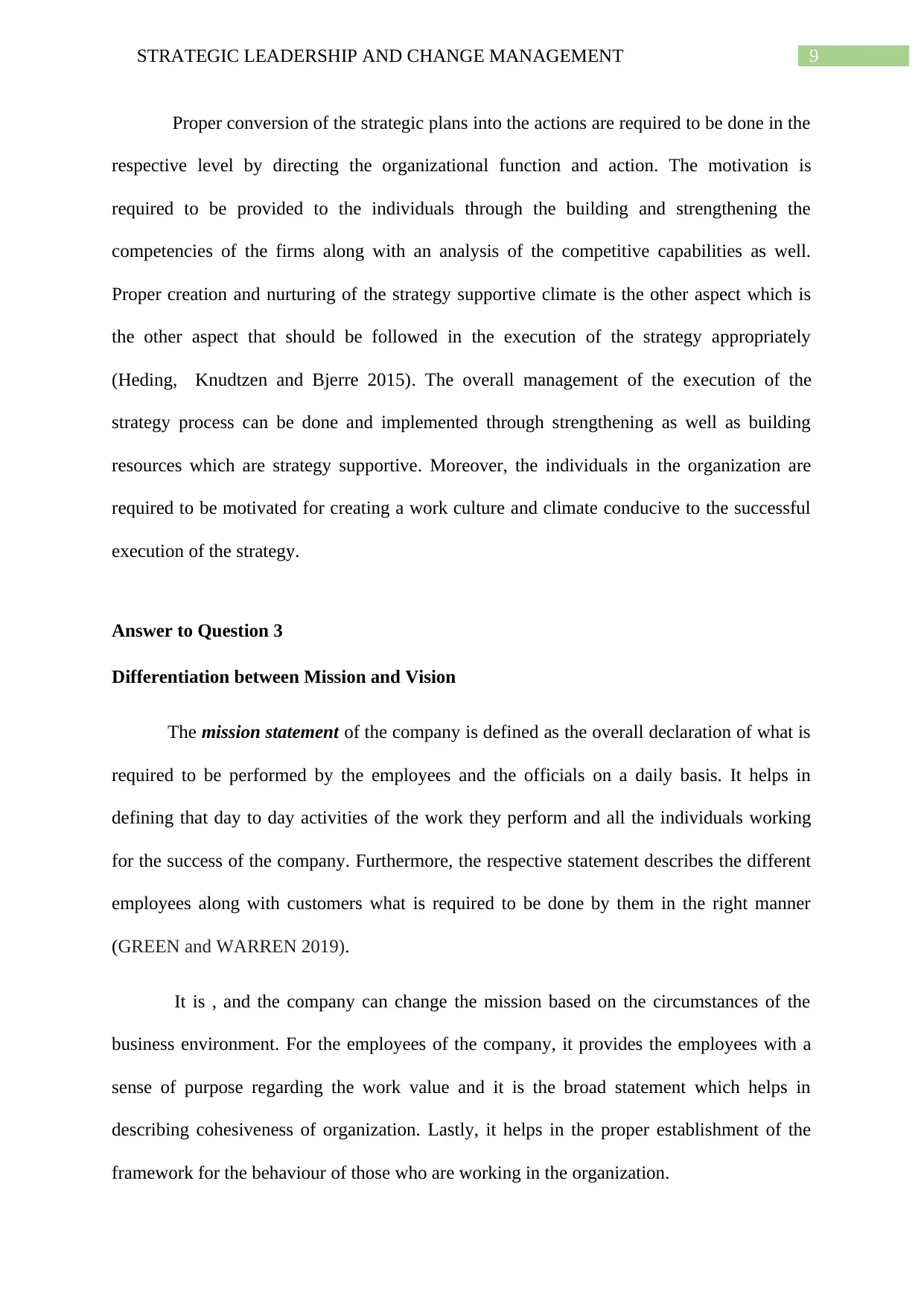
9STRATEGIC LEADERSHIP AND CHANGE MANAGEMENT
Proper conversion of the strategic plans into the actions are required to be done in the
respective level by directing the organizational function and action. The motivation is
required to be provided to the individuals through the building and strengthening the
competencies of the firms along with an analysis of the competitive capabilities as well.
Proper creation and nurturing of the strategy supportive climate is the other aspect which is
the other aspect that should be followed in the execution of the strategy appropriately
(Heding, Knudtzen and Bjerre 2015). The overall management of the execution of the
strategy process can be done and implemented through strengthening as well as building
resources which are strategy supportive. Moreover, the individuals in the organization are
required to be motivated for creating a work culture and climate conducive to the successful
execution of the strategy.
Answer to Question 3
Differentiation between Mission and Vision
The mission statement of the company is defined as the overall declaration of what is
required to be performed by the employees and the officials on a daily basis. It helps in
defining that day to day activities of the work they perform and all the individuals working
for the success of the company. Furthermore, the respective statement describes the different
employees along with customers what is required to be done by them in the right manner
(GREEN and WARREN 2019).
It is , and the company can change the mission based on the circumstances of the
business environment. For the employees of the company, it provides the employees with a
sense of purpose regarding the work value and it is the broad statement which helps in
describing cohesiveness of organization. Lastly, it helps in the proper establishment of the
framework for the behaviour of those who are working in the organization.
Proper conversion of the strategic plans into the actions are required to be done in the
respective level by directing the organizational function and action. The motivation is
required to be provided to the individuals through the building and strengthening the
competencies of the firms along with an analysis of the competitive capabilities as well.
Proper creation and nurturing of the strategy supportive climate is the other aspect which is
the other aspect that should be followed in the execution of the strategy appropriately
(Heding, Knudtzen and Bjerre 2015). The overall management of the execution of the
strategy process can be done and implemented through strengthening as well as building
resources which are strategy supportive. Moreover, the individuals in the organization are
required to be motivated for creating a work culture and climate conducive to the successful
execution of the strategy.
Answer to Question 3
Differentiation between Mission and Vision
The mission statement of the company is defined as the overall declaration of what is
required to be performed by the employees and the officials on a daily basis. It helps in
defining that day to day activities of the work they perform and all the individuals working
for the success of the company. Furthermore, the respective statement describes the different
employees along with customers what is required to be done by them in the right manner
(GREEN and WARREN 2019).
It is , and the company can change the mission based on the circumstances of the
business environment. For the employees of the company, it provides the employees with a
sense of purpose regarding the work value and it is the broad statement which helps in
describing cohesiveness of organization. Lastly, it helps in the proper establishment of the
framework for the behaviour of those who are working in the organization.
Paraphrase This Document
Need a fresh take? Get an instant paraphrase of this document with our AI Paraphraser
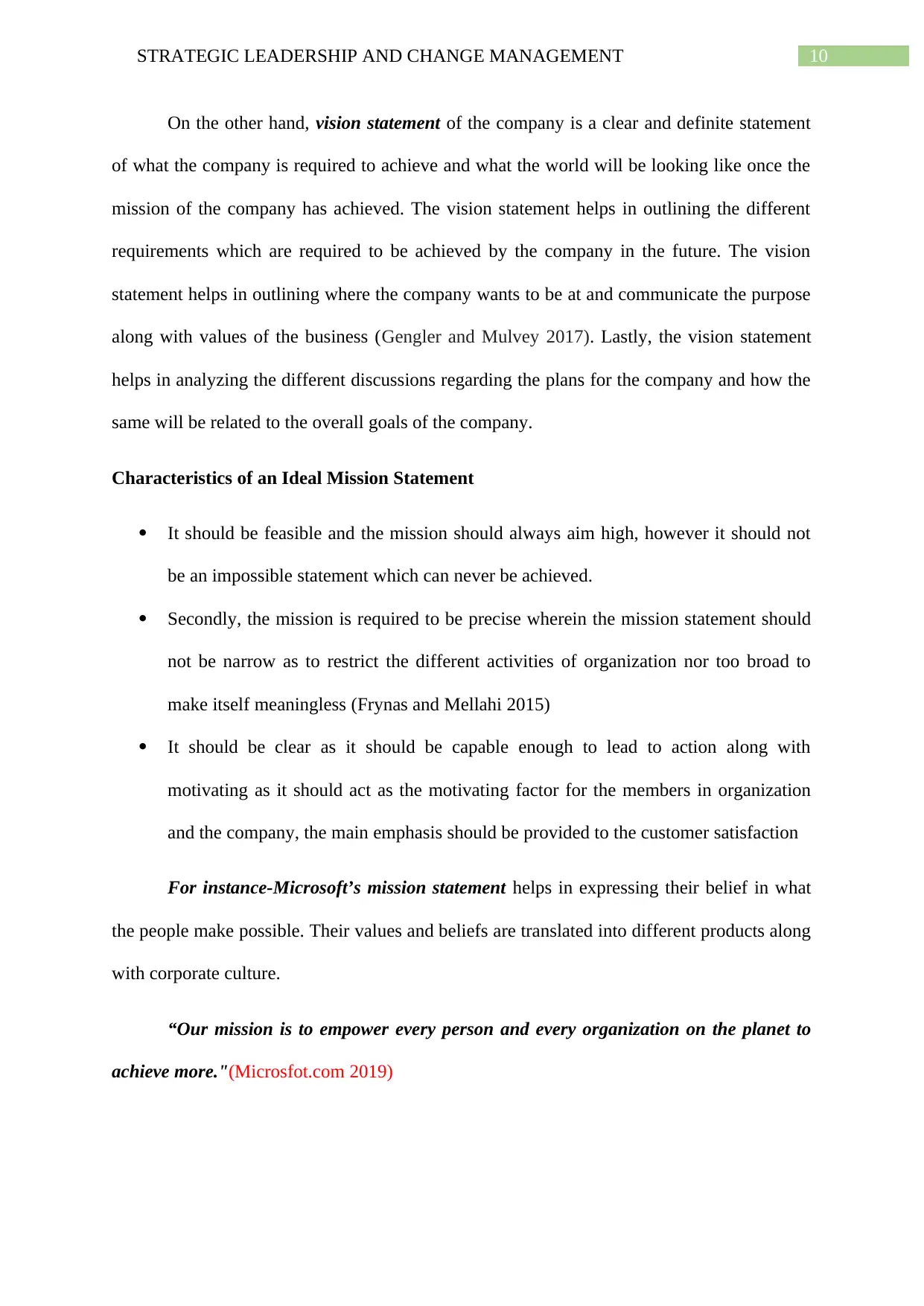
10STRATEGIC LEADERSHIP AND CHANGE MANAGEMENT
On the other hand, vision statement of the company is a clear and definite statement
of what the company is required to achieve and what the world will be looking like once the
mission of the company has achieved. The vision statement helps in outlining the different
requirements which are required to be achieved by the company in the future. The vision
statement helps in outlining where the company wants to be at and communicate the purpose
along with values of the business (Gengler and Mulvey 2017). Lastly, the vision statement
helps in analyzing the different discussions regarding the plans for the company and how the
same will be related to the overall goals of the company.
Characteristics of an Ideal Mission Statement
It should be feasible and the mission should always aim high, however it should not
be an impossible statement which can never be achieved.
Secondly, the mission is required to be precise wherein the mission statement should
not be narrow as to restrict the different activities of organization nor too broad to
make itself meaningless (Frynas and Mellahi 2015)
It should be clear as it should be capable enough to lead to action along with
motivating as it should act as the motivating factor for the members in organization
and the company, the main emphasis should be provided to the customer satisfaction
For instance-Microsoft’s mission statement helps in expressing their belief in what
the people make possible. Their values and beliefs are translated into different products along
with corporate culture.
“Our mission is to empower every person and every organization on the planet to
achieve more."(Microsfot.com 2019)
On the other hand, vision statement of the company is a clear and definite statement
of what the company is required to achieve and what the world will be looking like once the
mission of the company has achieved. The vision statement helps in outlining the different
requirements which are required to be achieved by the company in the future. The vision
statement helps in outlining where the company wants to be at and communicate the purpose
along with values of the business (Gengler and Mulvey 2017). Lastly, the vision statement
helps in analyzing the different discussions regarding the plans for the company and how the
same will be related to the overall goals of the company.
Characteristics of an Ideal Mission Statement
It should be feasible and the mission should always aim high, however it should not
be an impossible statement which can never be achieved.
Secondly, the mission is required to be precise wherein the mission statement should
not be narrow as to restrict the different activities of organization nor too broad to
make itself meaningless (Frynas and Mellahi 2015)
It should be clear as it should be capable enough to lead to action along with
motivating as it should act as the motivating factor for the members in organization
and the company, the main emphasis should be provided to the customer satisfaction
For instance-Microsoft’s mission statement helps in expressing their belief in what
the people make possible. Their values and beliefs are translated into different products along
with corporate culture.
“Our mission is to empower every person and every organization on the planet to
achieve more."(Microsfot.com 2019)
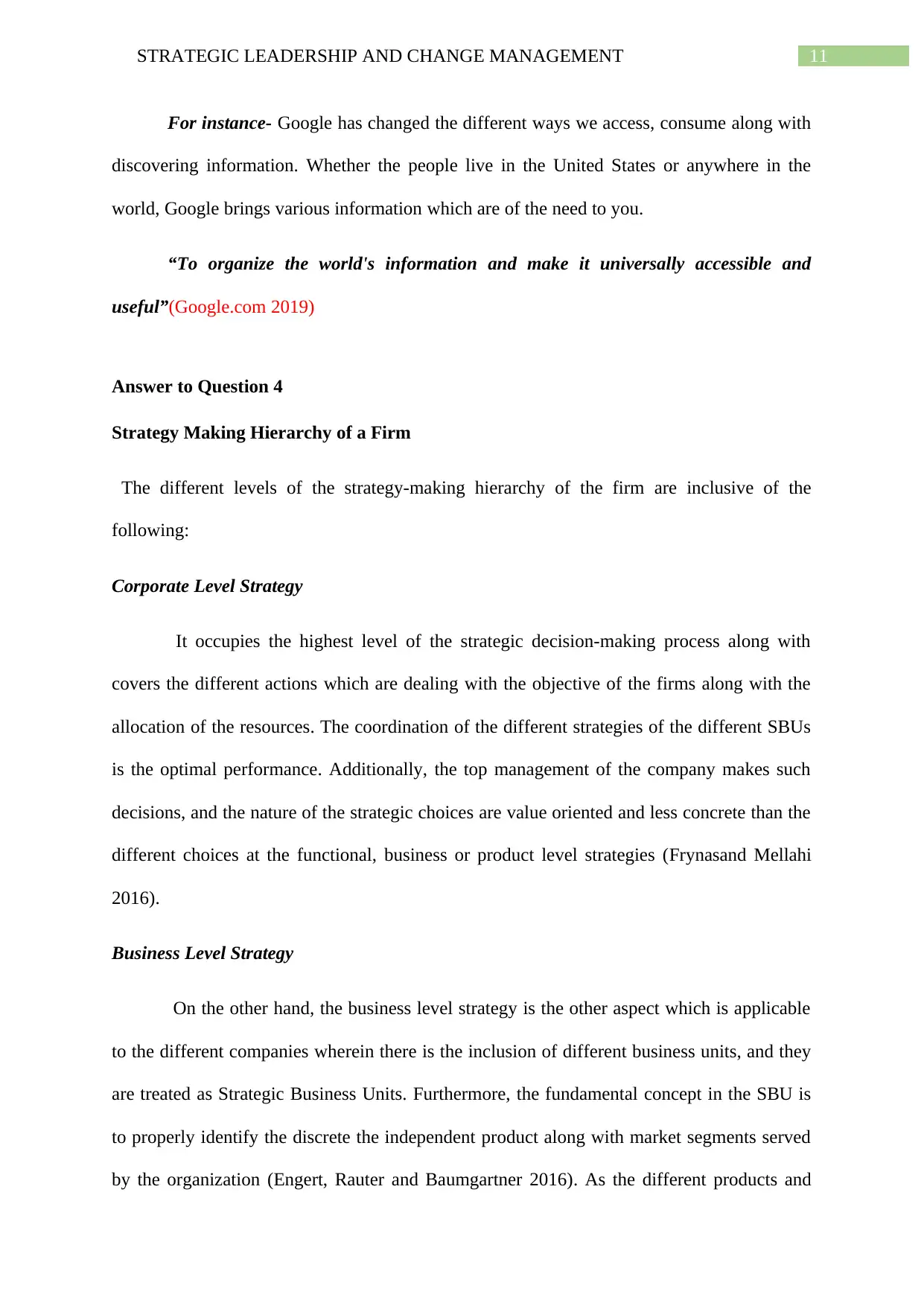
11STRATEGIC LEADERSHIP AND CHANGE MANAGEMENT
For instance- Google has changed the different ways we access, consume along with
discovering information. Whether the people live in the United States or anywhere in the
world, Google brings various information which are of the need to you.
“To organize the world's information and make it universally accessible and
useful”(Google.com 2019)
Answer to Question 4
Strategy Making Hierarchy of a Firm
The different levels of the strategy-making hierarchy of the firm are inclusive of the
following:
Corporate Level Strategy
It occupies the highest level of the strategic decision-making process along with
covers the different actions which are dealing with the objective of the firms along with the
allocation of the resources. The coordination of the different strategies of the different SBUs
is the optimal performance. Additionally, the top management of the company makes such
decisions, and the nature of the strategic choices are value oriented and less concrete than the
different choices at the functional, business or product level strategies (Frynasand Mellahi
2016).
Business Level Strategy
On the other hand, the business level strategy is the other aspect which is applicable
to the different companies wherein there is the inclusion of different business units, and they
are treated as Strategic Business Units. Furthermore, the fundamental concept in the SBU is
to properly identify the discrete the independent product along with market segments served
by the organization (Engert, Rauter and Baumgartner 2016). As the different products and
For instance- Google has changed the different ways we access, consume along with
discovering information. Whether the people live in the United States or anywhere in the
world, Google brings various information which are of the need to you.
“To organize the world's information and make it universally accessible and
useful”(Google.com 2019)
Answer to Question 4
Strategy Making Hierarchy of a Firm
The different levels of the strategy-making hierarchy of the firm are inclusive of the
following:
Corporate Level Strategy
It occupies the highest level of the strategic decision-making process along with
covers the different actions which are dealing with the objective of the firms along with the
allocation of the resources. The coordination of the different strategies of the different SBUs
is the optimal performance. Additionally, the top management of the company makes such
decisions, and the nature of the strategic choices are value oriented and less concrete than the
different choices at the functional, business or product level strategies (Frynasand Mellahi
2016).
Business Level Strategy
On the other hand, the business level strategy is the other aspect which is applicable
to the different companies wherein there is the inclusion of different business units, and they
are treated as Strategic Business Units. Furthermore, the fundamental concept in the SBU is
to properly identify the discrete the independent product along with market segments served
by the organization (Engert, Rauter and Baumgartner 2016). As the different products and
⊘ This is a preview!⊘
Do you want full access?
Subscribe today to unlock all pages.

Trusted by 1+ million students worldwide
1 out of 25
Related Documents
Your All-in-One AI-Powered Toolkit for Academic Success.
+13062052269
info@desklib.com
Available 24*7 on WhatsApp / Email
![[object Object]](/_next/static/media/star-bottom.7253800d.svg)
Unlock your academic potential
Copyright © 2020–2025 A2Z Services. All Rights Reserved. Developed and managed by ZUCOL.





